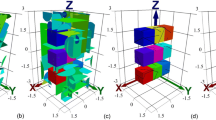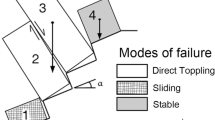Abstract
Squeezing ground is one of the major challenges associated with deep, high-stress mining. In underground hard rock mines, these conditions are often a result of the presence of prominent structural features such as foliation inside the rock mass, which imposes mechanical anisotropy and leads to a nonlinear and anisotropic response of the rock mass to mining. Understanding this response of foliated rocks to various mining conditions is essential for managing the squeezing ground conditions. The complex behavior of a foliated rock mass requires the use of numerical methods to investigate the response of the rock mass to mining. Discontinuum numerical methods are frequently used to simulate anisotropic behavior, as they can explicitly represent the fractures. However, these methods present time and computational restrictions for large-scale models and complex mining geometries. These limitations can be overcome by employing anisotropic constitutive models in continuum numerical methods. This paper presents a methodology to investigate the failure mechanism of an intact foliated rock sample and foliated rock mass around an underground excavation utilizing the ubiquitous-joint model in continuum numerical methods. The paper also presents an approach that can be used to investigate the influence of varying interception angles between the foliation and excavation walls on the severity of squeezing ground conditions. The ubiquitous-joint model employed in FLAC3D accounts for the presence of weakness planes such as foliations in continuum material and can successfully reproduce the observed displacements and failure mechanism. The numerical modeling results were in good agreement with the closure strains recorded underground.

















Similar content being viewed by others
References
Aydan Ö, Akagi T, Kawamoto T (1993) The squeezing potential of rocks around tunnels; theory and prediction. Rock Mech Rock Eng 26:137–163
Barla G (1995) Squeezing rocks in tunnels. ISRM News J 3(4):44–49
Barla G, Debernardi D, Sterpi D (2012) Time-dependent modeling of tunnels in squeezing conditions. Int J Geomech 12:697–710. https://doi.org/10.1061/(ASCE)GM.1943-5622.0000163
Beck DA, Kassbohm S, Putzar G 2010, Multi-scale simulation of ground support designs for extreme tunnel closure. In: Potvin Y (ed) Proceedings of the second international symposium on block and sublevel caving, australian centre for geomechanics, Perth, pp 441–453
Bewick RP (2008) Effects of anisotropic rock mass characteristics on excavation stability, MASc Thesis. Laurentian University. Sudbury, Canada
Board M, Chacon E, Varona P, Lorig L (1996) Comparative analysis of toppling behaviour at Chuquicamata open-pit mine, Chile. Trans Inst Min Metall Sect Min Ind 105:11–21
Clark IH (2006) Simulation of rock mass strength using ubiquitous joints. In: May RH, Verona P (eds) Proceedings of the 4th international FLAC symposium on numerical modelling in Geomechanics – 2006, Minneapolis, Itasca, Paper No. 08–07
Goricki A, Button E, Schubert W, Pötsch M, Leitner R (2005) The influence of discontinuity orientation on the behaviour of tunnels. Felsbau 23:2–18
Hadjigeorgiou J, Karampinos E, Turcotte P, Mercier-Langevin F (2013) Assessment of the influence of drift orientation on observed levels of squeezing in hard rock mines. In: Potvin Y, Brady B (eds) Proceedings of the seventh international symposium on ground support in mining and underground construction, Australian Centre for Geomechanics, Perth, pp 109–117
Hoek E (2001) Big tunnels in bad rock. ASCE J Geotech Geoenviron Eng 127:726–740. 20
Hsu S-C, Chiang SS, Lai JR (2004) Failure mechanisms of tunnels in weak rock with interbedded structures. Int J Rock Mech Min Sci 41:489. https://doi.org/10.1016/j.ijrmms.2003.12.024 (Proceedings of the ISRM SINOROCK 2004 symposium)
Ismael MA, Imam HF, El-Shayeb Y (2014) A simplified approach to directly consider intact rock anisotropy in Hoek–Brown failure criterion. J Rock Mech Geotech Eng 6:486–492. https://doi.org/10.1016/j.jrmge.2014.06.003
Itasca Consulting Group Inc (2012) FLAC3D—Fast Lagrangian Analysis of Continua (Version 5.0). Itasca, Minneapolis
Itasca Consulting Group Inc (2017) FLAC3D—Fast Lagrangian Analysis of Continua (Version 6.0). Itasca, Minneapolis
Karampinos E (2016) Management of squeezing ground conditions in hard rock mines. Ph.D. Thesis. University of Toronto. Toronto, Canada
Karampinos E, Hadjigeorgiou J, Turcotte P, Drolet M-M, Mercier-Langevin F (2014) Empirical and numerical investigation on the behaviour of foliated rock masses under high stress conditions. In: Hudyma M, Potvin Y (eds) Proceedings of the seventh international conference on deep and high stress mining, Australian Centre for Geomechanics, Perth, pp 345–361
Karampinos E, Hadjigeorgiou J, Hazzard J, Turcotte P (2015) Discrete element modelling of the buckling phenomenon in deep hard rock mines. Int J Rock Mech Min Sci 80:346–356. https://doi.org/10.1016/j.ijrmms.2015.10.007
Kolymbas D, Fellin W, Kirsch A (2006) Squeezing due to stress relaxation in foliated rock. Int J Numer Anal Methods Geomech 30:1357–1367. https://doi.org/10.1002/nag.530
Leitner R, Pötsch M, Schubert W (2006) Aspects on the numerical modelling of rock mass anisotropy in tunnelling. Felsbau 24:59–65
Li G, Li H, Kato H, Mizuta Y (2003) Application of ubiquitous joint model in numerical modeling of hilltop mines in Japan. Yanshilixue Yu Gongcheng Xuebao Chinese J Rock Mech Eng 22:951–956
Malan DF (2002) Manuel Rocha Medal recipient simulating the time-dependent behaviour of excavations in hard rock. Rock Mech Rock Eng 35:225–254. https://doi.org/10.1007/s00603-002-0026-0
Mellies G (2009) Two case studies of excavations in fractured rock. M.Sc. Thesis. Laval University. Quebec, Canada
Mercier-Langevin F, Hadjigeorgiou J (2011) Towards a better understanding of squeezing potential in hard rock mines. Min Technol 120(1):36–44. https://doi.org/10.1179/037178411X12942393517372
Mercier-Langevin F, Turcotte P (2007) Evolution of ground support practices at Agnico-Eagle’s LaRonde Division—innovative solutions to high-stress yielding ground. In: Eberhardt E, Stead D, Morrison T (eds) Rock mechanics, meeting society’s challenges and demands. Taylor & Francis Group, London, pp 1497–1504
Mishra AK, Panigrahi DC, Behera PK, Sinha RK, Munshi B (2015) Geotechnical lab testing of drill core samples from RA UG mine, internal report HZL. Indian School of Mines, Dhanbad
Potvin Y, Hadjigeorgiou J (2008) Ground support strategies to control large deformations in mining excavations. J S Afr Inst Min Metall 108:397–404
Rocscience Inc (2008) Phase2—finite element analysis for excavations and slopes. Rocscience, Toronto
Rocscience Inc (2017) RocData—rock, soil and discontinuity strength analysis. Rocscience, Toronto
Sainsbury BL, Sainsbury DP (2017) Practical use of the ubiquitous-joint constitutive model for the simulation of anisotropic rock masses. Rock Mech Rock Eng 50:1507–1528. https://doi.org/10.1007/s00603-017-1177-3
Sainsbury B, Pierce M, Mas Ivars D (2008) Analysis of caving behaviour using a synthetic rock mass (SRM)—ubiquitous-joint rock mass (UJRM) modelling technique. In: Potvin Y, Carter J, Dyskin A, Jeffery R (eds) Proceedings of the 1st southern hemisphere international rock mechanics symposium, vol 1, pp 243–253. Perth, Australia, 2008
Sandy MP, Gibson W, Gaudreau D (2007) Canadian and Australian ground support practices in high deformation environments. Deep Min 7:297–311
Schubert W, Mendez JMD (2017) Influence of foliation orientation on tunnel behavior. Proc Eng 191:880–885. https://doi.org/10.1016/j.proeng.2017.05.257
Szwedzicki T (2007) A hypothesis on modes of failure of rock samples tested in uniaxial compression. Rock Mech Rock Eng 40:97–104. https://doi.org/10.1007/s00603-006-0096-5
Vakili A, Sandy M, Albrecht J (2012) Interpretation of nonlinear numerical models in geomechanics—a case study in the application of numerical modelling for raise bored shaft design in a highly stressed and foliated rock mass. In: Proceedings sixth international conference and exhibition on mass mining, Massmin 2012, 10–14 June 2012, Sudbury, Ontario, Canada, The Canadian Institute of Mining, Metallurgy and Petroleum
Vakili A, Albrecht J, Sandy M (2014) Rock strength anisotropy and its importance in underground geotechnical design. In: Proceedings AusRock 2014, second Australasian ground control in mining conference, 5–6 November 2010, pp 167–180, Sydney, New South Wales, Australia, The Australasian Institute of Mining and Metallurgy 2014
Vyazmensky A, Yadav P (2015) Ground control management plan Rampura Agucha underground project. Internal report. Hindustan Zinc Limited, Rajasthan
Wang T, Xu D, Elsworth D, Zhou W (2016) Distinct element modeling of strength variation in jointed rock masses under uniaxial compression. Geomech Geophys Geo-Energy Geo-Resour 2:11–24. https://doi.org/10.1007/s40948-015-0018-7
Watson JM, Vakili A, Jakubowski M (2015) Rock strength anisotropy in high stress conditions: a case study for application to shaft stability assessments. Stud Geotech Mech. https://doi.org/10.1515/sgem-2015-0013
Yadav P, Panda A, Sonam M, Banerjee B, Parihar S, Paneri DC (2016) Influence of foliation on excavation stability at Rampura Agucha underground mine. In: Proceedings recent advances in rock engineering (RARE 2016). National Institute of Rock Mechanics. Bengaluru, India
Yao H, Jia S, Li H (2017) Experimental study on failure characteristics of schist under unloading condition. Geotech Geol Eng. https://doi.org/10.1007/s10706-017-0364-z
Zhao Q, He Z (2011) The ubiquitous-joint model and its application in predicting the strength of stratified rock. In: Ge L, Zhang X, Gomes A, Wu J (eds) Instrumentation, testing, and modeling of soil and rock behavior, 2011. ASCE, Hunan, China, pp 115–122
Acknowledgements
The authors acknowledge the support of the senior management and the geotechnical department of Hindustan Zinc Limited. The authors also acknowledge the Itasca Consulting Group Inc. for providing FLAC3D through the Itasca education partnership program. The financial support from Laurentian University is acknowledged.
Author information
Authors and Affiliations
Corresponding author
Additional information
Publisher’s Note
Springer Nature remains neutral with regard to jurisdictional claims in published maps and institutional affiliations.
Rights and permissions
About this article
Cite this article
Yadav, P., Sharan, S. Numerical Investigation of Squeezing in Underground Hard Rock Mines. Rock Mech Rock Eng 52, 1211–1229 (2019). https://doi.org/10.1007/s00603-018-1632-9
Received:
Accepted:
Published:
Issue Date:
DOI: https://doi.org/10.1007/s00603-018-1632-9




